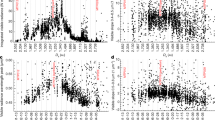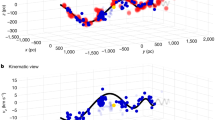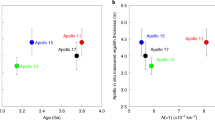Abstract
Raup and Sepkoski1 have presented evidence from marine fossils for a 26-Myr periodicity in the occurrence of mass extinctions. Using the same data Rampino and Stothers2 obtained a different period, 30±1 Myr, which agrees with the 33±3-Myr half-period for the vertical oscillation of the Solar System about the plane of the galaxy3. To explain this agreement they suggest2 that encounters with molecular clouds perturb the Sun's family of comets, causing many to enter the inner Solar System where one or more collide with the Earth; the cloud encounter rate is modulated at twice the oscillation frequency, because the number density of clouds peaks at the galactic plane at the midpoint of the solar oscillation crossed by the Solar System twice per period. Notwithstanding an apparent objection to this that the most recent extinctions are not in phase with the solar oscillation4, their model, given its stochastic nature, can accommodate a few events with large phase discrepancies. The degree of modulation is crucial: it depends on the scale height of the population of molecular clouds relative to the amplitude of the solar motion and tends to zero if this ratio is large and encounters are entirely random. Here we present data from CO surveys of molecular clouds both within and beyond the solar circle, which permit explicit calculation of the strength of the modulation. The cloud layer near the Sun is too extended and, as a consequence, the modulation of cloud encounters is too weak for a statistically significant period to be extracted from the nine extinctions analysed by Rampino and Stothers.
This is a preview of subscription content, access via your institution
Access options
Similar content being viewed by others
References
Raup, D. & Sepkoski, J. Proc. natn. Acad. Sci. U.S.A. 81, 801–805 (1984).
Rampino, M. R. & Stothers, R. B. Nature 308, 709–712 (1984).
Innanen, K. A., Patrick, A. T. & Duley, W. W. Astrophys. Space Sci. 57, 511–515 (1978).
Davis, M., Hut, P. & Muller, R. A. Nature 308, 715–717 (1984).
Bahcall, J. Astrophys. J. 276, 156–168 (1984).
Thaddeus, P. Ann. N.Y. Acad. Sci. 395, 9–16 (1982).
Allen, C. W. Astrophysical Quantities, 252 (Athlone, London, 1973).
Dame, T. M. & Thaddeus, P. Bull. Am Astr. Soc. 14, 616 (1982).
Casoli, F., Combes, F. & Gerin, M. Astr. Astrophys. 133, 99–109 (1984).
Bailey, M. E. Mon. Not. R. Astr. Soc. 204, 603–633 (1983).
Sanders, D. B., Solomon, P. M. & Scoville, N. Z. Astrophys. J. 276, 182–203 (1984).
Author information
Authors and Affiliations
Rights and permissions
About this article
Cite this article
Thaddeus, P., Chanan, G. Cometary impacts, molecular clouds, and the motion of the Sun perpendicular to the galactic plane. Nature 314, 73–75 (1985). https://doi.org/10.1038/314073a0
Received:
Accepted:
Issue Date:
DOI: https://doi.org/10.1038/314073a0
This article is cited by
-
The fundamental role of giant comets in earth history
Celestial Mechanics and Dynamical Astronomy (1992)
-
The Oort cloud
Nature (1990)
-
Celestial mechanics: Orbital evolution of comets
Nature (1986)
-
The Sun's motion perpendicular to the galactic plane
Nature (1985)
-
Catastrophism is still viable
Nature (1985)
Comments
By submitting a comment you agree to abide by our Terms and Community Guidelines. If you find something abusive or that does not comply with our terms or guidelines please flag it as inappropriate.



